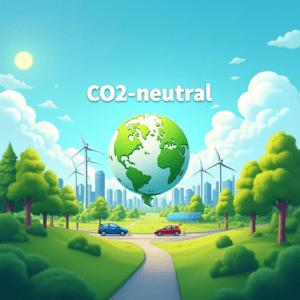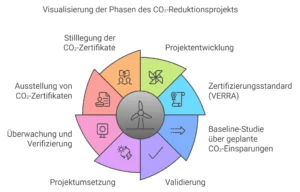The greenhouse effect is a natural phenomenon that is crucial for life on Earth. It describes the process in which certain gases in the Earth’s atmosphere, known as greenhouse gases, trap heat from the sun and radiate it back to the Earth’s surface. These gases, including carbon dioxide, methane, and water vapor, act like the glass panes of a greenhouse, holding the heat inside.
Without this effect, Earth would be a much colder place, and the temperatures would not be sufficient to support liquid water, which is essential for the survival of all known life forms. However, human influence on the environment in recent centuries has led to an enhancement of this natural process. Through industrial activities, deforestation, and the use of fossil fuels, we have significantly increased the concentration of these greenhouse gases in the atmosphere.
This leads to excessive warming of the Earth, known as anthropogenic greenhouse effect. While the natural greenhouse effect is necessary for survival, the enhanced effect poses serious challenges that we must urgently address.
Key Takeaways
- The greenhouse effect is a natural process that keeps the Earth warm by trapping heat in the atmosphere.
- The greenhouse effect occurs when certain gases in the atmosphere trap solar radiation and hold the heat in the atmosphere.
- The greenhouse effect impacts the climate, such as rising temperatures, altered precipitation patterns, and extreme weather events.
- The greenhouse effect affects biodiversity by changing habitats and threatening species.
- Humans play a crucial role in the greenhouse effect by releasing additional greenhouse gases into the atmosphere through the burning of fossil fuels and deforestation.
How does the greenhouse effect occur?
The greenhouse effect occurs through a complex interaction between solar radiation and the Earth’s atmosphere. When the sun reaches the Earth, a part of this energy is absorbed by the Earth’s surface and converted into heat. Another part is reflected back into space.
However, the greenhouse gases in the atmosphere trap much of this heat and prevent it from escaping into space. This process ensures that Earth has a pleasant average temperature that allows life to thrive. The formation of the greenhouse effect is influenced by various factors.
For example, human activities such as burning fossil fuels and agriculture contribute to an increase in the concentration of greenhouse gases. These additional gases intensify the natural effect and lead to excessive warming of the planet. The interactions between these gases and solar radiation are complex and are being intensively studied by scientists to better understand how we can combat climate change.
What are the impacts of the greenhouse effect on the climate?
The impacts of the greenhouse effect on the climate are far-reaching and affect nearly every aspect of our lives. One of the most obvious consequences is global warming, which leads to an increase in average temperatures on Earth. This not only affects the weather, but also the distribution of precipitation and extreme weather events.
We are experiencing more frequent heatwaves, droughts, and floods, which put significant strain on both human communities and ecosystems. In addition, the greenhouse effect causes sea levels to rise as the melting of glaciers and ice caps in the polar regions accelerates. This threatens coastal cities and island nations worldwide, forcing many people to relocate.
The oceans are also affected: they absorb some of the excess carbon dioxide, leading to ocean acidification, which endangers marine habitats. The changes in the climate are not just an abstract threat; they have concrete impacts on our environment and way of life. (Source: IPCC)
How does the greenhouse effect affect biodiversity?
| Aspect | Impact on biodiversity |
|---|---|
| Temperature rise | Increased risk of species extinction that are adapted to specific climate conditions |
| Habitat change | Loss of habitat for many species due to shifts in climate zones and changes in vegetation |
| Sea level rise | Loss of habitat for coastal and island species due to flooding |
| Extreme weather events | Increased stress for many species due to more frequent and intense extreme weather events |
The greenhouse effect has profound impacts on the biodiversity of our planet. The rising temperatures and changing climate conditions force many animal and plant species to change their habitats or adapt. Some species may be able to adapt or migrate to cooler regions, while others are at risk or may even go extinct.
These changes in habitats lead to a loss of biodiversity, which in turn disrupts the balance of ecosystems. Another problem is the rise of invasive species, which can spread in new areas while native species are under pressure. These invasive species often grow and reproduce faster than native species, leading to further declines in biodiversity.
The loss of biodiversity not only has ecological consequences, but also economic impacts, as many communities depend on healthy ecosystems to provide food, water, and other resources.
What role do humans play in the greenhouse effect?
Humans play a crucial role in the greenhouse effect, particularly through our activities that lead to an increase in the concentration of greenhouse gases in the atmosphere. The burning of fossil fuels for energy production, transportation, and industry is one of the main causes of the rise in carbon dioxide levels in the atmosphere. Additionally, agricultural practices such as livestock farming and the use of fertilizers contribute to the release of methane and nitrous oxide, two other potent greenhouse gases.
It is important to recognize that we are not only the cause of the problem, but also have the ability to find and implement solutions. By making conscious decisions in our daily lives, we can reduce our ecological footprint and contribute to combating climate change. The responsibility lies with all of us – governments, companies, and individuals – to work together to reduce the greenhouse effect and create a sustainable future.
What current measures are being taken to combat the greenhouse effect?
To combat the greenhouse effect, numerous measures have been taken worldwide. International agreements such as the Paris Agreement aim to limit global warming to below 2 degrees Celsius compared to pre-industrial levels. Countries are setting targets to reduce their greenhouse gas emissions and promote the transition to renewable energies such as solar and wind power.
These initiatives are crucial to reduce our reliance on fossil fuels and promote a more sustainable energy future. On a local level, there are also numerous initiatives to combat the greenhouse effect. Cities are implementing programs to promote public transportation, improve energy efficiency in buildings, and create green spaces.
Businesses are increasingly adopting sustainable practices by optimizing their production processes and developing environmentally friendly products. These collective efforts are essential to mitigate climate change and secure a livable future for generations to come.
How can you contribute to reducing the greenhouse effect in everyday life?
There are many ways you can contribute to reducing the greenhouse effect in everyday life. One of the simplest measures is to reduce your energy consumption. You can achieve this by using energy-efficient devices, turning off lights when leaving a room, and only using your heating or air conditioning when really necessary.
Reducing water consumption also helps save energy, as water treatment often requires a lot of energy. Another important step is to change your mobility. If possible, you should use public transportation or cycle instead of driving a car.
Car sharing or carpooling are also good alternatives. In addition, you can reconsider your consumption: buy local products and reduce meat consumption, as livestock farming contributes significantly to global emissions. By making conscious choices and encouraging others to do the same, you can have a positive impact on the environment.
What are the long-term consequences if the greenhouse effect is not mitigated?
If we cannot mitigate the greenhouse effect, we will face serious long-term consequences. Global warming could reach uncontrollable levels and extreme weather events such as hurricanes, floods, and droughts could become even more frequent. These changes would not only endanger the lives of many people, but also destabilize entire ecosystems and lead to a massive loss of biodiversity.
Furthermore, unchecked sea level rise could force millions of people in coastal areas to relocate and cause massive economic damage. Food production could be affected by changing climate conditions, leading to food shortages and rising prices. Ultimately, uncontrolled greenhouse effects could challenge our civilization and present us with challenges that we can hardly imagine today.
It is up to all of us to prevent this future and actively advocate for a sustainable world.
If you’re interested in the greenhouse effect and its impacts, I recommend checking out an article that discusses the need for a transportation and energy transition. This article provides deep insights into the measures that need to be taken to reduce CO2 emissions and combat the greenhouse effect. You can read the article here. It’s a great resource to learn more about the steps we can take as a society to protect our environment.



